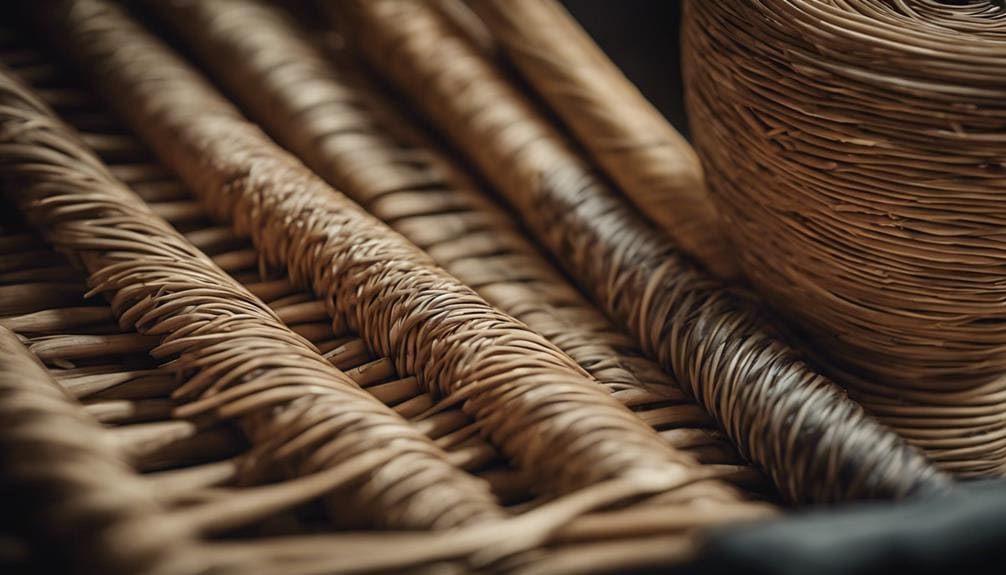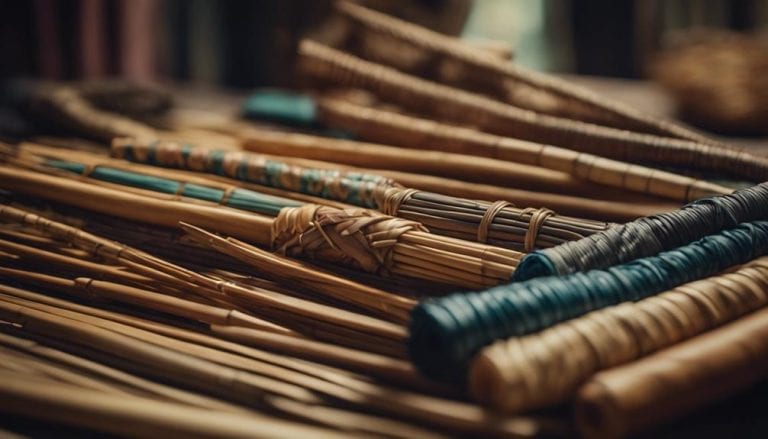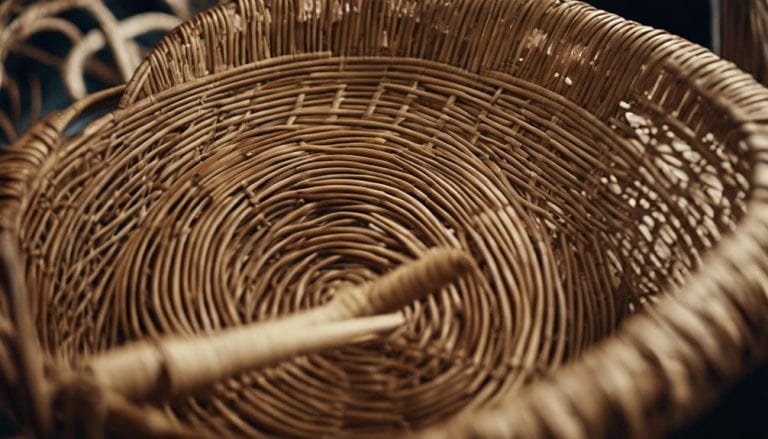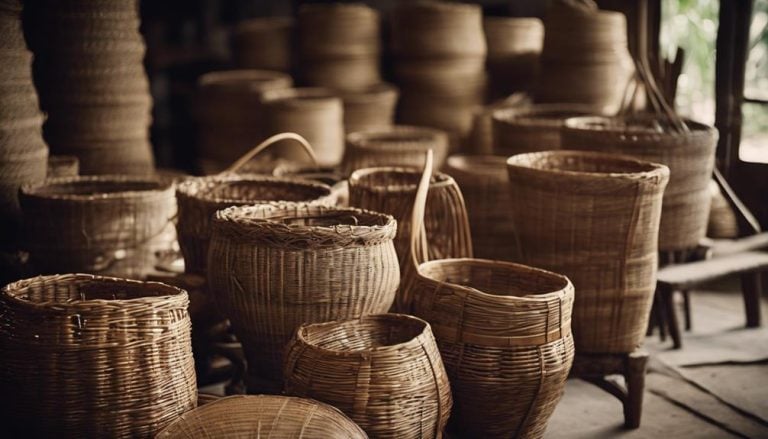Rattan Cane: A Weaving Material Overview
In furniture crafting, rattan cane has gracefully woven its way from an underappreciated resource to a cornerstone of design elegance and sustainability. I’ve spent considerable time exploring its journey, from its humble beginnings in 17th-century England to its modern resurgence in European decor.
Rattan’s unique properties—flexibility, durability, and eco-friendliness—make it a fascinating subject for anyone interested in sustainable materials. As we peel back the layers of its rich history and multifaceted applications, we discover a wealth of knowledge about how this material continues to shape trends and craftsmanship in the furniture industry.
In this overview of rattan cane as a weaving material, we explore its versatility and durability, making it a popular choice for furniture and decor. Rattan cane’s natural strength and flexibility lend themselves well to intricate weaving patterns, adding a touch of elegance to various design projects.
Key Takeaways
- Rattan cane, a sustainable material made from climbing palms, is ideal for weaving due to its flexibility and strength.
- Over 600 species exist, with Calamus often chosen for furniture due to its durability.
- The crafting process includes harvesting, processing, and weaving techniques, highlighting its versatility.
- Rattan’s maintenance is straightforward, enhancing its popularity for durable and eco-friendly furniture designs.
What Is Rattan?
What exactly is rattan, you might wonder? Let me guide you through this remarkable material’s intricate and fascinating world. Rattan is a type of climbing palm primarily found in the lush, tropical regions of Southeast Asia, Africa, and Australia. Unlike the typical palms you might envision, rattan plants boast slender, flexible vines, making them exceptionally ideal for weaving and crafting various objects, from furniture to decorative items.
As we delve deeper, it’s important to understand that rattan is not just any material. It emerges as a sustainable alternative to conventional resources like wood and metal, championing eco-friendliness without compromising strength or durability. Among the over 600 species, Calamus stands out, frequently chosen for its superior qualities in furniture and craftwork.
Embracing rattan means supporting a versatile, durable, and kind material to our planet. Its capacity for rapid growth and easier harvesting makes it a front-runner in sustainable practices, offering an innovative solution to our ever-growing environmental concerns. So, when you choose rattan, you’re opting for a path that’s as considerate to the Earth as it is to your aesthetic and functional needs.
Rattan’s Historical Significance
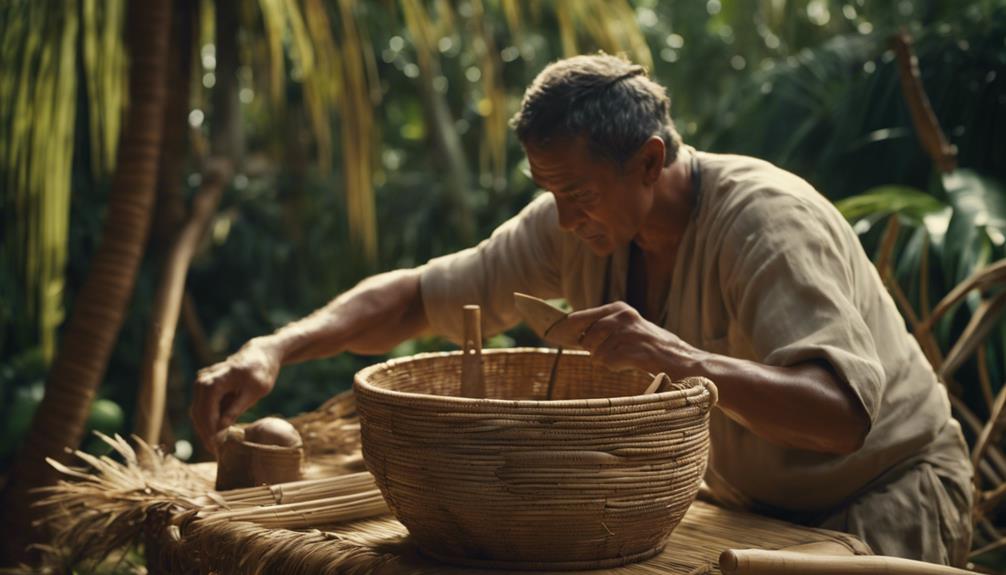
Delving into the annals of history, we find rattan’s role as a versatile and durable material, integral to furniture, basketry, and decorative arts for centuries, deeply woven into the fabric of Asian cultures and later capturing the global stage during the colonial era. Its journey from the dense forests of Asia to the elegant drawing rooms of Europe and America is a testament to its practicality and beauty. Rattan’s historical significance cannot be overstated, reflecting not just a material but a legacy of artisanal craftsmanship and cultural traditions.
Here’s a closer look at Rattan’s historical tapestry:
- Cultural Significance: Rattan carries profound cultural traditions within Asian societies, symbolizing a blend of functionality and artistry passed down through generations.
- Colonial Influence: Its global spread during the colonial era introduced rattan’s timeless appeal to a wider audience, merging local designs with Western tastes.
- Artisanal Craftsmanship: The intricate weaving techniques showcase skill and dedication to creating pieces with elegance and durability.
- Enduring Popularity: Rattan’s flexibility, resilience, and adaptability have cemented its status across various epochs. It continuously adapts to meet evolving aesthetic and functional demands.
Rattan’s story is one of innovation, tradition, and resilience, marking its indelible impact on design and culture worldwide.
Characteristics of Rattan
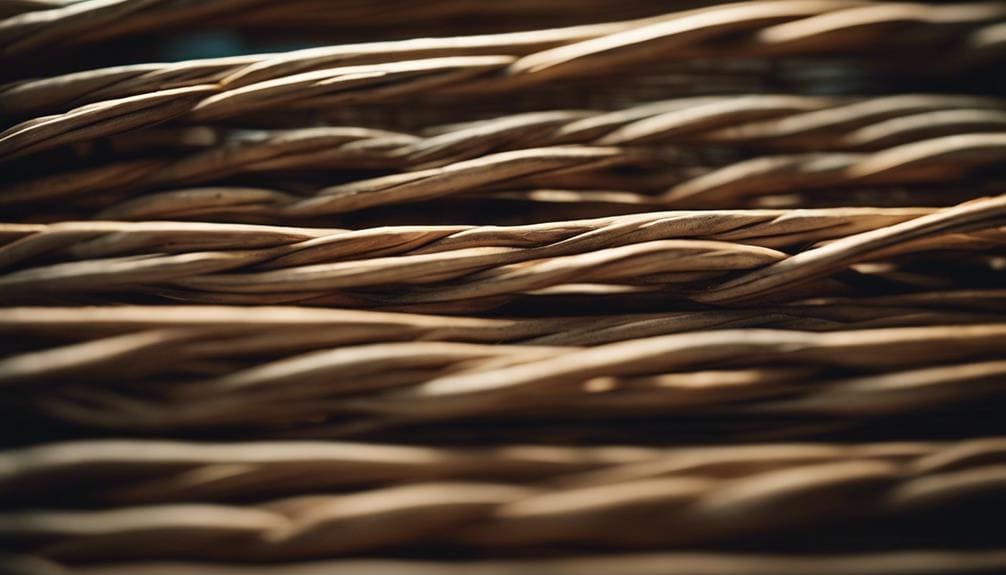
Rattan, a climbing palm renowned for its sturdy yet flexible stems, thrives in the lush tropical and subtropical forests spanning Asia and Africa. Its unique characteristics make it a standout in sustainable materials, particularly for interior design. With spiny, solid stems ranging from 1 to 2 inches in diameter, rattan combines durability with a lightweight nature, making it robust and easy to manipulate.
This climbing palm’s glossy surface contributes to its aesthetic appeal and underscores its eco-friendly credentials. Being biodegradable, rattan aligns with the growing demand for materials that minimize environmental impact. Its versatility is evident in the home goods it creates — from furniture to lampshades; each piece showcases rattan’s natural beauty and resilience.
The fact that rattan can last up to 10 years with proper care adds another layer to its appeal in interior design. It’s not just about crafting visually stunning objects; it’s also about investing in sustainable and durable pieces. Rattan perfectly encapsulates this ethos with its seamless blend of form and function.
Harvesting and Processing

Harvesting the inner bark of rattan palms, a process critical for obtaining its shiny and durable fibers typically unfolds during the dry season to streamline drying and transportation. This period’s low humidity and abundant sunshine are perfect for the task, making it a pivotal moment in rattan cane preparation. Traditional techniques ensure the ecosystem’s preservation and the rattan palms’ sustainability, an aspect I deeply respect.
Here’s a breakdown of the process:
- Cutting: I carefully select mature rattan palms, using traditional tools to cut them at the base. This ensures minimal damage to the surrounding vegetation and promotes sustainable growth.
- Bundling: I then gather the canes, bundling them together for ease of transportation. This step requires a keen eye for sorting the canes by size and quality.
- Oil Curing and Air Drying: I apply natural oils to the canes, a technique passed down through generations. The canes are left to dry under the sun, naturally enhancing their durability.
- Straightening and Polishing: I straighten the canes using heat and manual techniques. A final polish ensures they’re ready for the next stage, excluding weaving, which belongs to a different phase of their journey.
Dry season harvesting and these traditional techniques are not just about processing rattan; they’re about honoring heritage and ensuring the material’s legacy continues.
Rattan Cane in Crafting
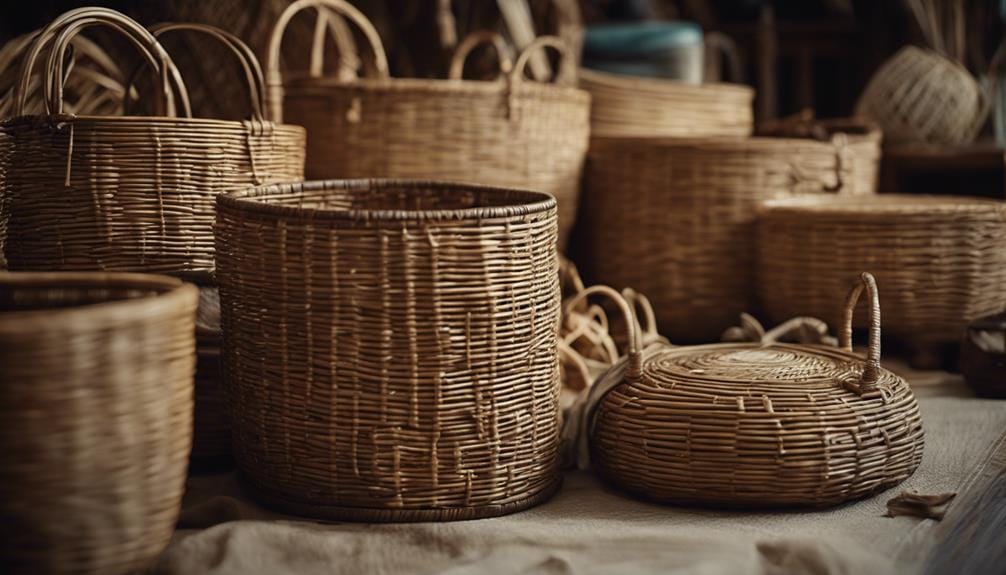
In crafting, I’ve found that the inner bark of rattan palms, with its inherent flexibility and strength, is an unparalleled material for weaving intricate designs in furniture, baskets, and home décor. This unique medium allows me to explore various creative patterns and artistic creations, pushing the boundaries of traditional craftsmanship.
| Crafting Technique | Application in Rattan Crafting |
|---|---|
| Interlocking Weave | Creates durable furniture frames |
| Spiral Coil | Forms the base for intricate baskets |
| Herringbone Pattern | Enhances aesthetic appeal of home décor |
| Open Weave | Allows for breathable, lightweight designs |
Utilizing specific techniques, I can manipulate rattan cane into many shapes and designs, each with unique charm and function. The natural properties of rattan contribute to the durability of the crafted items and lend an earthy, warm aesthetic that’s highly sought after in both traditional and modern interiors.
Crafting with rattan cane is a technical yet deeply personal endeavor. Each piece I create is a testament to the versatility and beauty of this material, showcasing the potential of natural resources when approached with innovation and respect for traditional crafting methods.
Care and Maintenance Tips

After exploring the creative potential of crafting with a rattan cane, it’s crucial to consider how best to preserve these intricate pieces through effective care and maintenance strategies. The longevity of rattan furniture heavily relies on the cleaning techniques and preservation methods employed.
Here’s how I ensure my rattan creations stand the test of time:
- Dust Regularly: I gently wipe down my rattan items with a soft cloth. This simple action prevents the accumulation of dirt and grime, which can degrade the material over time.
- Avoid Direct Sunlight: I carefully position my rattan away from direct sunlight to prevent it from drying out or cracking. This precaution is essential for preserving its natural beauty and structural integrity.
- Periodic Deep Cleaning: I meticulously clean my rattan pieces using a mild soap solution and a soft brush. This process removes stubborn dirt without damaging the delicate fibers.
- Moisture Control and Protection: I keep my rattan dry and well-ventilated to combat moisture, which can lead to mold and mildew. A protective wax or sealant enhances its luster and protects against potential damage.
Modern Uses of Rattan

Why has rattan cane become a cornerstone in modern furniture design, celebrated for its robustness, adaptability, and green credentials? It’s simple. This material not only withstands the test of time due to its durability but also bends with the winds of change, thanks to its flexibility. Its eco-friendly nature seals the deal for those yearning to make responsible, sustainable choices.
In contemporary furniture, rattan cane is no longer just about crafting traditional pieces. It’s about innovating. We’re seeing chairs that aren’t just seated but are statements, decorative panels that tell a story, and intricate designs that blur the lines between functionality and art. This transition is a testament to rattan’s versatility and ability to meld with various design philosophies, from minimalist to bohemian.
Modern designers push the envelope, integrating rattan in ways that challenge our perceptions of sustainable furniture. Their innovative designs pay homage to rattan’s rich history and propel it into the future. As someone deeply invested in the sustainable movement, I’m excited to see how rattan continues to evolve, proving that innovative design and environmental stewardship can go hand in hand.
Frequently Asked Questions
What Is Rattan Cane Made Of?
I’ve learned that rattan cane comes from the inner bark of the rattan palm. Its growth and sustainability efforts make it a strong, flexible choice for weaving. It’s a material that’s both durable and intimate.
What Is Rattan Weaving?
Rattan weaving is an art blending cultural significance with sustainability practices. It’s not just crafting; it’s innovating durable, intricate designs. I’m deeply connected to this craft, cherishing its natural beauty and technical finesse in every weave.
What Is the Use of Cane in Weaving?
Cane’s the backbone of my weaving projects, offering unmatched durability and craft versatility. It’s perfect for creating durable, intricate chair seats. Its flexibility fuels my innovation, letting me explore endless design possibilities intimately.
What Is a Weaving Cane?
I’ve discovered that a weaving cane, celebrated for its durability and historical significance, is a marvel of craftsmanship. It’s not just any material; it’s a testament to the enduring beauty and innovation in weaving arts.
Conclusion
In weaving through the tapestry of time, rattan has emerged as a stalwart champion of craftsmanship and sustainability. Its journey from the dense forests to the heart of our homes is remarkable. As I’ve unraveled, rattan’s resilience and versatility breathe life into creations that intertwine tradition with innovation. Its eco-conscious footprint steps lightly, promising a greener future. So, as we craft and care for our rattan treasures, we’re not just preserving a legacy but weaving a better tomorrow.

